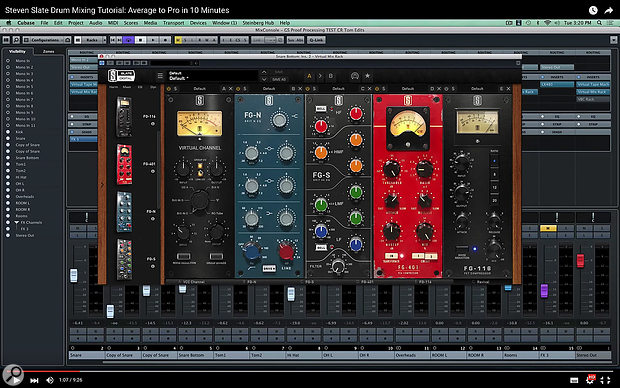 In his video tutorial, Steven Slate shows you that you can achieve great results with the ‘top-down’ mixing method, in which you work back from the bus. But is it always the best approach?
In his video tutorial, Steven Slate shows you that you can achieve great results with the ‘top-down’ mixing method, in which you work back from the bus. But is it always the best approach?
I watched a video by Steven Slate [available at https://youtu.be/iocdFlUgzl0] where he demonstrates a ‘top down’ method of mixing drums. In other words, instead of starting with compression and EQ on individual mic channels, you start working on the drum bus first and work your way down. What do you think about this idea?
SOS Forum post
Mix specialist Mike Senior replies: This idea has been around for a long while, and can be applied to your entire mix, not just the drums. There are a number of potential benefits of working in this way, but the main one is speed. If you need to get optimum results within a limited time-frame, it makes sense to start with broad brush-strokes that get you closest to a usable end result in minimum time. And working fast makes it easier to keep hold of the ‘big picture’, aesthetically speaking, rather than getting too side-tracked by minutiae. With multi-miked recordings, there’s the added technical advantage that processing all the mics at once, rather than individually, avoids tampering with the complex phase interactions between them. Furthermore, if you’re going to use master-output processors to creatively colour your mix (say, giving a vintage vibe with saturation or tape-emulation plug-ins, or adding a bus compressor that’s bucking like a mule for rock music), then it may be impossible to judge your per-channel mix moves reliably until those processors are active.
However, the top-down approach does have its weaknesses. On a technical level, internal phase-relationships between the different mics of any ensemble recording (such as a drum-miking setup) can be critical to the sound, and if you don’t optimise those before the bus processing, they have the potential to completely invalidate your settings. To take an extreme example, if you’ve EQ’d and transient-processed the drums bus to enhance the snare drum, and only realise afterwards that the under-snare mic is out of polarity with the over-snare mic, then you’ll probably have to back-track on much of that processing work.
I think the top-down approach can feel quite frustrating too, once you get beyond the first round of easy-win mix improvements and start trying to compete with commercial releases. The problem is that some of the less tangible (but important) mix characteristics such as ‘clarity’, ‘sustain’, ‘depth’ and ‘groove’ are, in my experience, much more the cumulative product of many tiny mix tweaks than of larger-scale processing manoeuvres. If it feels like you’ve put together 80 percent of a mix in an hour using top-down methods, it’s going to be pretty tough to discipline yourself to spend another (say) two days on detailed work to achieve the remaining 20 percent that separates you from the market competition. As such, it’s my experience that the top-down approach frequently encourages less experienced mixers to overprocess their buses, instead of engaging with painstaking but vital nitty-gritty tasks.
Fundamentally, though, I think the end is more important than the means, and although both top-down and bottom-up mindsets have enthusiastic supporters, I don’t think either has a monopoly amongst world-class engineers. In my view, project-studio owners get best results if they can develop a mixing workflow that balances benefits from both approaches. For example, I personally prefer to deal with phase, balance, and basic masking issues on a per-track basis before getting too involved with bus processing, but also don’t like delving too far into per-channel balance details before activating any global master-bus processing. Does that make me a bottom-up or top-down mixer? I don’t think it really matters, as long as I know how to get results that way.
